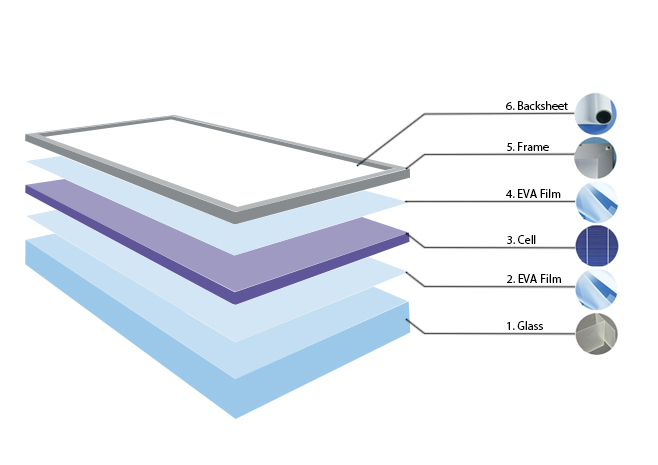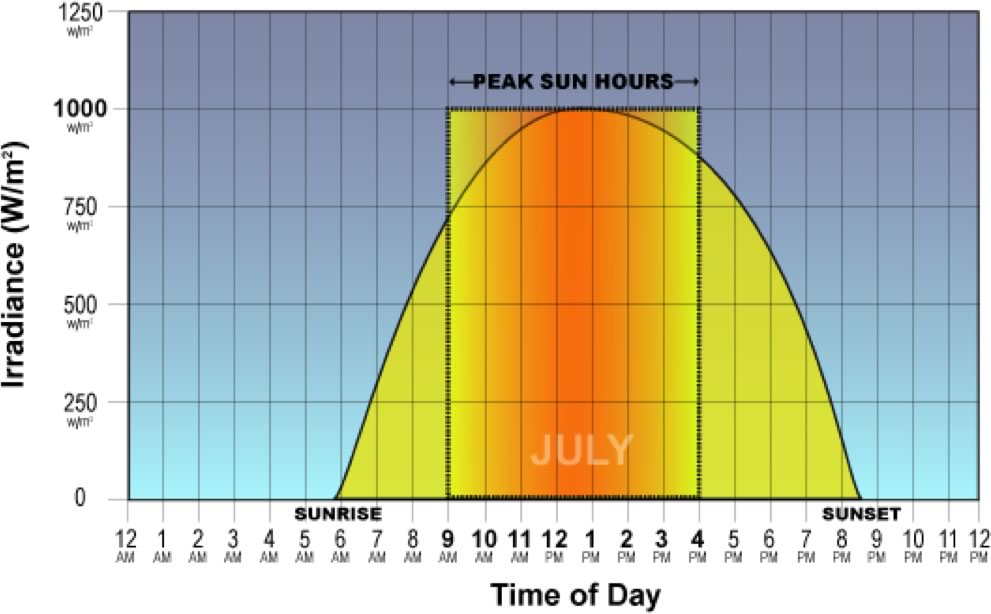Solar Panels in the basic sense work by converting available sunlight into usable electricity. The way we define this power is by watts. Watts are made up of amps and volts. Different panels have different ratings for amps and volts, and it is helpful to understand what these numbers mean when you are looking at a system. You can imagine amps as the amount of electrons, and the voltage the amount of pressure pushing those electrons.
Equation: Watts = Volts x Amps
A solar panel is made up of different components as seen in below model. Not all panels will have these specific components in the specific locations, but generally our panels have this.

Solar Cell: The solar cells can be seen on front of the solar panel. They vary in color and appearance based depending on the type of cell. The type of cell generally defines what kind of panel it is, for example monocrystalline, polycrystalline, amorphous, etc.
Frame: Most Higon Solar panels have an aluminum frame, but depending on the type of panel frame type can vary.
Junction Box: The junction box is generally located on the back of the panel. It contains bypass diodes to help with power loss due to shading. Also it serves as a connection and a holder for the panel wires.
PV Cable: Our Higon solar panels come with standard PV wire that is weatherproof and insulated (as long as there is no exposed copper cable).
MC4 Connector: At the end of the PV wire is a MC4 connector. This MC4 connector is standard in the PV industry, is weatherproof and serves as a connection point to our other MC4 cable, such as an adaptor kit.

Monocrystalline solar panels are slightly higher in efficiency than polycrystalline panels because each utilizes a different manufacturing technique. A monocrystalline cell consists of a single crystal ingot, whereas a polycrystalline cell consists of a growth containing multiple crystal structures. Both types of cells are made from silicon ingots, but the purity requirement of the silicon is higher on a monocrystalline base. Therefore, monocrystalline panels are more efficient, and thus, more expensive. By using a single cell, monocrystalline based silicon allows the electron greater freedom to move, so less energy is lost and higher efficiency is created. Most monocrystalline cells peak at 22% efficiency, whereas most polycrystalline cells peak at 18% efficiency. Monocrystalline cells are a dark blue almost appearing black, and polycrystalline cells are blue.
It is important to use the peak hours with the wattage of your system to calculate how many watt hours your system produces in a day. You can view peak sun hours as an average, as basing power off the hours of daylight during the day isn’t sufficient. The reason why is because sunlight in the morning and evening will not produce as much radiation as solar during midday. To calculate each states peak hours, the radiation is averaged based on the highs and lows and also other factors such as what is mixed into the atmosphere.
As you can see from the data gathered below model, the level of irradiance or W/m2 varies throughout the day. The panels output is directly related to the W/m2 at that given time. Most solar panels are rated at 1000 W/m2. If the irradiance level is let’s say 500 W/m2, like it is at 8am in the graph, then you should expect half the output (50%). Because of this fact, the solar peak hours of your state isn’t how long the sun it out, but an average from the lows and the highs so that it can be a reliable number in calculating energy generation.

One of the most important concepts to understand when sizing a system or figuring out how much your panel produces is Energy and Power. Below you will be able to find a description about each along with some examples.
Power is defined as rate of doing work. It essentially tells you how quickly you can produce energy. Power takes on different forms, but when dealing with electricity or solar, you will define power as a Watt. As stated before, Watts = Volts x Amps. Multiplying the panel’s voltage by amperage will give you a wattage value. This is also true for an appliance. You can also think of power in terms of how much money you make hourly at a job, ie. $8/hour.
Energy is the capacity for doing work. It essentially tells you how much work can be done. Energy can take different forms, but when dealing with electricity or solar, you will define energy as Watt Hours. Watt Hours = Watts x Hours. Multiplying an appliances wattage, by how long it will run for will give you its energy value. Multiplying a panel’s wattage by the peak solar hours will give you its energy value. You can also think of energy in terms your paycheck, if you make $8/hour and work for 5 hours, you have $8 x 5 Hours = $40.
For Solar Panels, the energy produced is dependent on how much sun you get in your location. Sun hours will vary from different countries, but it is important to have an idea of what your states peak solar hours are. For example let's look at a 500W panel in Germany vs. Thailand. Using Germany's low value of 4 peak hours and Thailand's low value of 6 peak hours we can calculate the energy or Watt-Hours produce by the panel. For Germany 500 Watts x 4 Hours = 2000 Watt Hours. For Thailand, 500 Watts x 6 Hours = 3000 Watt Hours. As you can see the state location does have an impact on energy production, in this case by 1000 Watt Hours.
For appliances, the energy produced is dependent on the wattage value of the appliance along with the hours of run time. It is very important that you have the wattage, not just the voltage or amperage as those aren’t complete power values. For appliances, you can take the voltage and multiply it by the amperage. For example, an 6 Amp Fridge at 220V will be 6 Amps x 220 Volts = 1320 Watts.
Let’s take two 35 Watt fans. One we will run for 2 hours and the other for 5 hours. The first fan consumes 35 Watts x 2 Hours = 70 Watt Hours and the second fan consumes 35 Watts x 5 Hours = 175 Watt Hours. As you can see, given the same fan, the second one takes more energy since it is ran for longer.
We can also relate energy to our batteries as well. Often times we get told that a customer has a 12V or 6V battery. As from what you saw earlier, this is not a complete form of energy, so just having this information is not enough to determine how much your batteries can store. We need to find the Watt-Hours value. Luckily most batteries are rated in a term called Amp-Hours. Although this has hours in it, it still isn’t energy. To get Watt-Hours we must multiply Amp-Hours by Volts.
Amp-Hours x Volts = Watt-Hours
For example let’s say we have two batteries, one 6V and one 12V. The 6V battery is rated at 100 Amp-Hours and the 12V battery is rated at 75 AH. The energy of the first battery is 6Vx100Amp-Hours= 600 Watt-Hours. The energy of the second battery is 12V x 75 AH = 900 Amp-Hours. As you can see even though the first battery has more Amp-Hours, it does not have more energy or storage.
When connecting solar panels in a system, the way they are connected plays an important role in the amount of voltage or amps being sent from the panels for charging and energy purposes. The three main ways you can connect solar panels with each other are connecting them in series, parallel, and series-parallel.
When connecting panels in series, you connect the positive wire from one panel to the negative wire of the next panel, and so on. The voltage values of each panel are added up together, and the amperage values are not added up and stay the same no matter how many solar panels you connect in series.
 Parallel Connection
Parallel ConnectionWhen connecting panels in parallel, you connect the positive or negative wire from one panel to the positive or negative wire of the next panel, and so on. In parallel connections, you connect the wires with the same sign between panels. You would also likely need branch connectors to finish the parallel connections of the solar panel wires. When connecting panels in parallel, the voltage values are not added up and stay the same no matter how many panels you connect in parallel, and the amperage values of each panel are added up together.
When connecting panels in series-parallel, the panels are wired together in series to form strings of panels. After that, the strings of series-connected panels are connected to each other in parallel. This results in adding up the voltage of each panel and leaving the amperage value of the panels the same within the connected string of panels, but then also adding up the amperage values of each panel string after connecting each string in parallel. The number of times the amperage values from the strings would be added would depend on how many panel strings are connected in parallel.